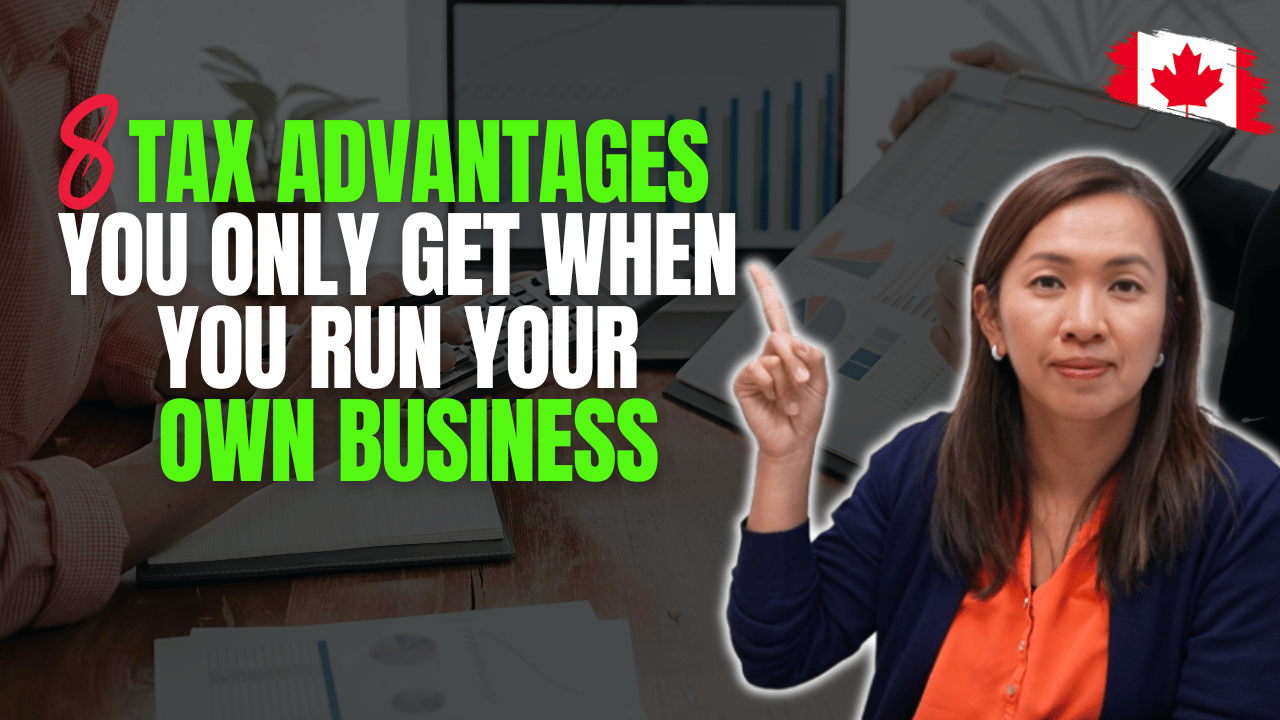If you’re running a business in Canada—whether you’re incorporated or not—there are real, powerful tax strategies available to help you reduce your taxes and reinvest more into your business.
These aren’t loopholes. They’re structured incentives, built into the Income Tax Act, to support entrepreneurship, risk-taking, and economic growth.
Here’s a breakdown of the most valuable tax incentives entrepreneurs should be taking advantage of in 2025.
1. Incorporation and the Small Business Tax Rate
Canada uses a progressive personal income tax system, which means the more you earn, the more tax you pay—not just in total, but on each additional dollar.
If you earn $150,000 in employment income, you don’t pay one flat rate. Instead, your income is divided into brackets, and each portion is taxed at a different marginal rate. To calculate your total tax, you’d go through each bracket, multiply the income within that bracket by the corresponding rate, and add it all up.
In practice, this means someone earning $150,000 in Ontario would pay approximately $50,000 in personal income taxes—plus Canada Pension Plan (CPP) and Employment Insurance (EI) premiums.
When you incorporate your business, you gain access to the small business tax rate on the first $500,000 of active business income. In Ontario, that rate is just 12.2% in 2025.
So, if your corporation earns $150,000 in net income, it pays only $18,300 in tax—far less than the $50,000+ you’d pay on the same amount of employment income at the personal level.
That’s because the corporation is treated as a separate legal entity. It pays its own tax, and you only pay personal tax when you withdraw the money (via salary or dividends).
But here’s the key: the tax system is designed to integrate the two levels of tax. When you pay yourself a dividend, you receive a dividend gross-up and tax credit, which offsets part of the corporate tax already paid. In theory, this ensures that the combined corporate and personal tax ends up similar to what you’d pay personally—but with one major advantage: you control the timing.
This means you can:
- Leave money in the corporation to reinvest at a lower tax cost
- Smooth your personal income over multiple years
- Split income with a spouse (if structured properly)
Bottom line: Incorporation is one of the most powerful tools in a business owner’s tax toolbox—not because it eliminates tax, but because it gives you control over when and how much tax you pay.
2. Tax Deferral: Keep Money Working for You
Because a corporation is a separate legal entity, you don’t pay personal tax until you actually withdraw funds from the company. This creates an opportunity to defer personal tax—possibly for years—by leaving income inside the corporation.
This deferral allows you to:
- Reinvest profits to grow your business or build investment assets
- Use your corporation as a future savings vehicle
- Avoid bumping yourself into higher personal tax brackets in any one year
3. Income Smoothing: Use Lower Tax Brackets Each Year
The best part of Canada’s progressive tax system is that every individual gets access to the lower tax brackets each year. With a corporation, you can spread your withdrawals over time—paying yourself just enough annually to take advantage of those lower brackets.
Instead of pulling out $150K in a single year and paying top marginal rates, you could draw $60K–$70K per year over multiple years—keeping your average tax rate much lower.
And when you pay yourself dividends, the system provides an integration mechanism: a dividend gross-up and tax credit that offsets some of the corporate tax already paid.
This combination—low corporate tax, personal tax deferral, and income smoothing—makes incorporation one of the most powerful long-term tax planning tools for business owners.
4. Income Splitting with Family Members (Yes, It’s Still Possible)
Although the Tax on Split Income (TOSI) rules have tightened the ability to income split, entrepreneurs with corporations still have legitimate ways to share income with family members—and reduce the overall family tax bill.
Here are three proven strategies:
a) Pay Reasonable Salaries
If your spouse or children do actual work for your business, you can pay them a salary. The amount must be reasonable for the work performed, and ideally documented with:
- A written job description
- Timesheets or work logs
- T4 slips and source deductions (CPP, EI if applicable)
Example: A teenager who handles social media, does filing, or updates website content can be paid for their time—at a rate consistent with market wages.
b) Issue Shares for Dividends
If your spouse or adult children own at least 10% of both the voting and value shares of the corporation (and the business earns less than 90% of its income from providing services), TOSI does not apply to dividends paid to them.
This structure can allow you to pay dividends to lower-income family members, potentially at very low or even zero tax rates.
Bottom Line
While TOSI rules closed many doors, income splitting is still very much alive—if you’re structured properly, keep clean records, and plan ahead.
With the right setup, you can legitimately shift income to lower-taxed family members and reduce the overall household tax burden.
5. Lifetime Capital Gains Exemption (LCGE)
One of the most generous tax incentives available to Canadian entrepreneurs is the Lifetime Capital Gains Exemption (LCGE).
If you sell shares of a Qualified Small Business Corporation (QSBC), you may be able to shelter up to $1,250,000 (2025 limit, indexed) in capital gains from tax.
To qualify:
- You must have owned the shares for at least 24 months.
- During those 24 months, more than 50% of the company’s assets must have been used in an active business in Canada.
- At the time of sale, at least 90% of the assets must be used in active business (this is the “purification” test).
Advanced Planning Opportunity:
With the right structure, you can multiply the exemption using:
- Spouses or adult children as shareholders
- A family trust, where multiple beneficiaries can claim their own $1.2M exemption
Why it matters:
If your corporation sells for $3.6M, and three family members each claim the exemption, you could pay zero tax on the sale.
This is a major planning opportunity for anyone building a business with an eventual exit in mind—especially those in professional services, tech, and real estate development.
6. Tax Credits and Incentives for Business Owners
Entrepreneurs also have access to a range of tax credits and government incentives that aren’t available to employees or sole proprietors. These can directly reduce your tax bill or provide funding for growth and hiring.
Common tax credits and programs include:
- Ontario Co-operative Education Tax Credit
If your business hires co-op students, you can receive a refundable credit of up to 25% (or 30% for small businesses) of eligible wages—up to $3,000 per student per term. - Scientific Research & Experimental Development (SR&ED) Program
If your business develops new or improved processes, technologies, or products, you may qualify for refundable tax credits of up to 35% on eligible R&D expenses. - Digital Media and Innovation Credits (province-specific)
Available in certain jurisdictions for companies developing digital products, games, or e-learning platforms.
Key Point:
Most of these programs require proactive planning, recordkeeping, and filings. If you don’t know they exist, you likely won’t apply—or qualify.
A proactive accountant or advisor can help you capture thousands of dollars in additional tax savings and incentives.
7. Pre-Tax Deductions vs. Tax Credits: The Hidden Advantage of Being Incorporated
One of the biggest advantages of being a business owner is the ability to pay for certain expenses using corporate pre-tax dollars, rather than your personal after-tax income.
What’s the difference?
- A pre-tax deduction reduces your taxable income before tax is calculated. You get full value.
- A tax credit is applied after tax is calculated—often non-refundable, and only worth a fraction of the expense.
This difference becomes massive when you break it down in real dollars.
Example: $4,000 in Medical Expenses
As an employee or paying personally:
- You need to earn ~$6,500 in gross income
- Pay income tax first (say 40%)
- Use your after-tax money to pay the bill
- Then get a small non-refundable tax credit (~$248 in 2025 if you exceed the income threshold)
As a business owner with a corporation:
- Your corporation pays $4,000 (plus admin fee) through a Health Spending Account (HSA)
- Gets a full tax deduction
- You’re reimbursed personally, tax-free
- No need to gross up income, no personal tax triggered
Bottom line: You save $1,800+ simply by flowing the expense through your corporation.
Other Common and Powerful Pre-Tax Deduction Tools:
Health Spending Account (HSA)
As shown above, it converts after-tax personal medical expenses into fully deductible corporate expenses—while reimbursing you tax-free.
Individual Pension Plan (IPP)
A retirement plan for incorporated professionals over 40 with steady income:
- Contributions are made by the corporation
- Fully deductible to the business
- Generates higher contribution room than RRSPs for older owners
- Funds grow tax-deferred in a creditor-protected account
Charitable Donations (via Corporation)
A donation made personally gives you a non-refundable tax credit.
A donation made by your corporation provides a full deduction against income. This lowers your corporation’s tax payable up front.
Why This Matters
If you’re an employee or sole proprietor, your tax relief options are mostly limited to small credits. You have to:
- Earn more
- Pay personal tax
- Then get a small amount back
It’s inefficient—and costly.
If you’re incorporated, you can:
- Deduct expenses at the corporate level
- Reimburse yourself tax-free
- Keep more money in your business and personal accounts
Tax credits are okay. Pre-tax deductions are powerful.
And only business owners have access to the full toolkit.
8. Writing Off Business Expenses: What You Can and Can’t Deduct
One of the most common things people believe about running a business is:
“You can write off everything!”
The truth is more nuanced.
The CRA only allows you to deduct expenses that are reasonable and incurred for the purpose of earning business income. That means the expense must have a clear connection to your business activities.
That said, business owners—especially those who are incorporated or self-employed—do have more flexibility in claiming legitimate expenses that employees cannot.
Here are some key deductions to understand:
Home Office Expenses
If you work from home, you may deduct a portion of your home expenses, including:
- Mortgage interest or rent
- Property taxes
- Utilities
- Internet
- Insurance
- Repairs and maintenance
To qualify, your home office must be:
- Your principal place of business, or
- Used exclusively for earning business income and regularly meeting clients there
You’ll need to calculate the business-use portion based on square footage or number of rooms.
Automobile Expenses
If you use your car for business, you can deduct:
- Fuel
- Insurance
- Maintenance and repairs
- Lease payments or capital cost allowance (for owned vehicles)
- Licensing and registration
- 407 ETR tolls
- CAA membership
- Business-use parking
Keep a mileage log. CRA expects you to track business use vs. personal use—don’t guess.
Other Legitimate Business Expenses
- Phone and Internet: Only the business-use portion is deductible
- Software and subscriptions: CRM tools, accounting software, Adobe, Canva, etc.
- Office supplies and equipment: Pens, printer ink, desks, monitors
- Advertising and marketing: Google Ads, social media, website design
- Meals and entertainment: 50% of costs are deductible if related to business development and properly documented (client name, purpose, receipt)
- Professional fees: Legal, accounting, tax, consulting
- Education and training: Courses, certifications, and seminars related to your business
What You Can’t Deduct
- Clothing (unless it’s safety gear or branded uniforms)
- Groceries or meals for yourself (unless you’re traveling or meeting a client)
- Personal expenses disguised as business (CRA watches for this)
Final Word
You can’t deduct your life just because you own a business.
But with proper recordkeeping and structure, you can deduct a significant number of legitimate expenses—and that can make a meaningful difference in your bottom line.
And the best part? Every dollar you deduct through your corporation is a dollar you don’t pay personal tax on.
Until next time, happy Canadian Real Estate Investing.
Cherry Chan, CPA, CA
Your Real Estate Accountant





